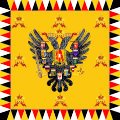Flags of Austria-Hungary
From Wikipedia, the free encyclopedia
During its existence, Austria-Hungary did not have a common flag – a "national flag" could not exist since the Dual Monarchy consisted of two sovereign states. However, the black-gold flag of the ruling Habsburg Dynasty was sometimes used as a de facto national flag and a common civil ensign was introduced in 1869 for civilian vessels. Until 1918, the k.u.k. War Fleet continued to carry the Austrian ensign it had used since 1786 and the regiments of the k.u.k. Army carried the double-eagle banners they had used before 1867, as they had a long history in many cases. New ensigns created in 1915 were not implemented due to the ongoing war. At state functions, the Austrian black-gold and the Hungarian red-white-green tricolor were used.
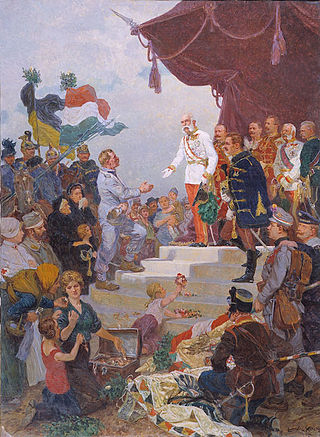
Austria was represented by the black-gold flag. The Hungarian half of the state, on the other hand, legally had no flag of its own.[1] According to the Croatian–Hungarian Settlement (art. 62 and 63), in all joint Croatian and Hungarian affairs, symbols of both Croatia and Hungary respectively had to be used. For instance, whenever the joint Hungarian-Croatian Parliament held its session in Budapest, both the Croatian and Hungarian flags were hoisted on the parliament building in Budapest.[1][2][3] In Vienna, in front of Schönbrunn Palace, the black and gold flag was flown for Cisleithania (Austrian half), while both Croatian and Hungarian flags were flown for Transleithania (Hungarian half).[3] Hungary proper used a red-white-green tricolor defaced with the Hungarian coat of arms, sometimes used to represent the entirety of the Lands of the Hungarian Crown. The "double" civil ensign, as a symbol of "corporate identity", was also used as the consular flag, as decreed on 18 February 1869. It came into use on 1 August 1869. Legations, however, flew the black-and-gold flag of Austria alongside the red-white-green flag of Hungary, while embassies flew the two national flags alongside the imperial standard.[4]
National and state flags
- Flag of the Habsburg Monarchy (including the Austrian and Austro-Hungarian Empires), also used to represent Cisleithania
- Flag of the Kingdom of Hungary also used to represent Transleithania
- Flag of the Kingdom of Hungary (coat of arms variant without supporters)
- Flag of the Kingdom of Hungary (civil flag)
- Flag of the Kingdom of Croatia-Slavonia
- Unofficial,[a] but common flag of the Kingdom of Croatia-Slavonia
- Flag of the Kingdom of Croatia-Slavonia (civil flag)
Imperial and military standards
Ensigns
Civil ensigns
- Civil ensign 1786–1869[7]
- Civil ensign 1869–1918[8]
- Unofficial Hungarian civil ensign used on Transleithania inland waters[7]
Naval ensigns
- Naval ensign 1915–1918
(not implemented)[9]
Regional flags
Additionally, several flags were in use within the local territories of Austria-Hungary.
| Location | Region name | Flag | |||
|---|---|---|---|---|---|
 |
Archduchy of Austria (Lower Austria) |
 | |||
 |
Archduchy of Austria (Upper Austria) |
 | |||
 |
Kingdom of Bohemia |  | |||
 |
Kingdom of Dalmatia |  | |||
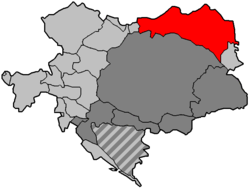 |
Kingdom of Galicia and Lodomeria |  (1849–1890)  (1890–1918) | |||
 |
County of Tyrol |  | |||
 |
Duchy of Bukovina |  | |||
 |
Duchy of Upper and Lower Silesia |  | |||
 |
Duchy of Carinthia |  | |||
 |
Duchy of Carniola |  | |||
 |
Duchy of Salzburg |  | |||
 |
Duchy of Styria |  | |||
 |
Margraviate of Moravia |  | |||
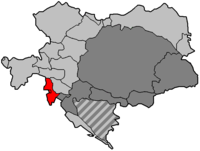 |
Austrian Littoral, including:
Princely County of Gorizia and Gradisca |
 (Austrian Littoral)
| |||
 |
Vorarlberg |  | |||
| Location | Region name | Flag | |||
 |
Kingdom of Hungary |  | |||
 |
Principality of Transylvania |  | |||
 |
Voivodeship of Serbia and Banat of Temeschwar |  | |||
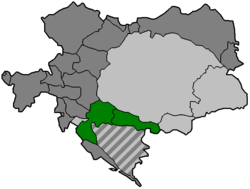 |
Kingdom of Croatia-Slavonia |  | |||
 |
Kingdom of Croatia |  | |||
 |
Kingdom of Slavonia |  | |||
 |
City of Fiume and its District |  | |||
| Location | Region name | Flag | |||
 |
Condominium of Bosnia and Herzegovina |  | |||
Examples of using flags in the era
- Visit of Emperor Franz Joseph I in Zagreb, red-white-blue (Croatian) flags, 1895
- Civil ensign and Austrian pennants on a French illustration advertising the Hungarian pavilion during Exposition Universelle in Paris, 1900
- Numismatic postcard designed by German businessman (Hugo Semmler) from 1900 with the Civil Ensign
- Emperor Franz Joseph I in Merano (black-yellow flag), 1900
- Bohinj tunnel opening ceremony (two-color flags), 1906
- Military base of Austro-Hungarian Army (two-color flag), 1910
- Poster from Österreichischer Lloyd showing the civil ensign and the company's logo on a navy blue flag, 1910
- SS Carniola - Austro-Hungarian civilian steamship with civil ensign, 1912
- Military parade in Vienna (two-color flags), 1913
- Imperial Standard on the car of Archduke Franz Ferdinand, 1914
- Soldiers of Infanterieregiment Nr. 17 with two-color flag, 1914
- Austro-Hungarian propaganda poster encouraging to buy war bonds
- World War I-era propaganda postcards depicting the flags of the Central Powers. The Austro-Hungarian flag shown as black-yellow
- A propaganda postcard commemorating the release of the Przemyśl fortress. Austria-Hungary represented by the black-yellow and red-white-green flags, 1915
- Another Central Powers propaganda, with Austria-Hungary being represented by a mix of both Habsburg and Hungarian flags
- Copy of the naval ensign taken by the Italian army from the submarine U12 at the Piave river mouths on 5 August 1915 (exposed in Museo Storico Navale, Venice).
- Emperor Charles I visiting Pergine (two- and three-color flags), 1917
- Vienna Praterstrasse, 1917
- Emperor Charles I visiting troops in Ozhydiv (two- and three-color flags), 1917
- Emperor Charles I in front of the Hungarian flag, 1917
- Emperor Charles I visiting one of the villages in South Tyrol (two-color flag), 1917
- SMS Gäa - Austro-Hungarian torpedo carrier with naval ensign, World War I period
Wikimedia Commons has media related to Austro-Hungarian flags in art.
Wikimedia Commons has media related to Austro-Hungarian flags on photographs.
See also
References
Wikiwand - on
Seamless Wikipedia browsing. On steroids.







